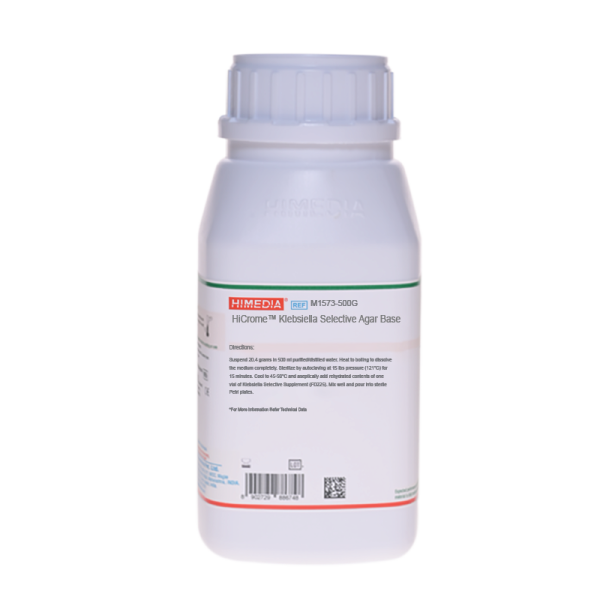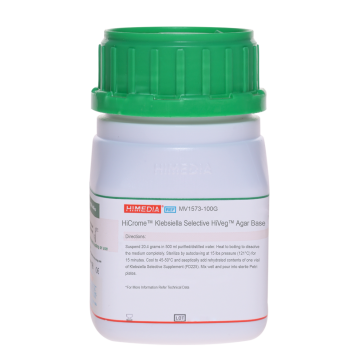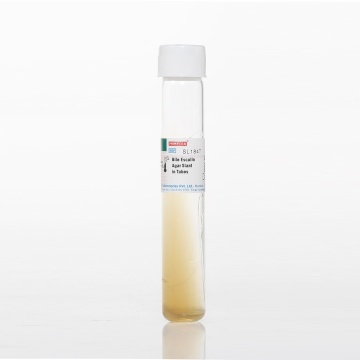 Your enquiry has been submitted
Your enquiry has been submitted
HiCrome™ Klebsiella Selective Agar Base
Intended use
Recommended for the selective isolation and easy detection of Klebsiella species from water and other sources. This medium can also be used in membrane filtration procedure.
Composition**
| Ingredients | g / L |
|---|---|
| Peptone, special | 12.000 |
| Yeast extract | 7.000 |
| Sodium chloride | 5.000 |
| Bile salts mixture | 1.500 |
| Sodium lauryl sulphate (SLS) | 0.100 |
| Chromogenic mixture | 0.200 |
| Agar | 15.000 |
Final pH ( at 25°C): 7.1±0.2
**Formula adjusted, standardized to suit performance parameters
Directions
Suspend 20.4 gram in 500 ml purified/distilled water. Heat to boiling to dissolve the medium completely. Sterilize by autoclaving at 15 lbs pressure (121°C) for 15 minutes. Cool to 45-50°C and aseptically add rehydrated contents of one vial of CarbK Selective Supplement (FD225). Mix well and pour into sterile Petri plates.
Principle And Interpretation
HiCrome™ Klebsiella Selective Agar Base is recommended for isolation and enumeration of Klebsiella species based on chromogenic differentiation. Klebsiella pneumoniae strains are widely distributed in the environment and contribute to biochemical and geochemical process (1). K. pneumoniae causes severe often fatal pneumonia. It also proves to be the source of lung infections that generally occur in patients with debilitating conditions such as alcoholism, diabetes mellitus, and chronic obstructive pulmonary disease (2). The chromogenic substrate incorporated in the media is cleaved specifically by Klebsiella species. K. pneumoniae, the causative agent of pneumonia, produces a purple-magenta coloured colony thereby aiding in the easy detection of the organisms. Most of the frequently encountered gram-negative faecal contaminants are inhibited on this media using a selective supplement.
Peptone special and yeast extract provides carbon, nitrogen substances, long chain amino acids, vitamins and other essential nutrients required for the growth of the organism. Sodium chloride maintains the osmotic equilibrium of the medium. Bile salts mixture and sodium lauryl sulphate (SLS) inhibit most of the accompanying flora. Addition of the selective supplement further increases the selectivity of the medium.
Type of specimen
Water samples.
Specimen Collection and Handling
For water samples, follow appropriate techniques for sample collection, processing as per guidelines and local standards (3). After use, contaminated materials must be sterilized by autoclaving before discarding.
Warning and Precautions
Read the label before opening the container. Wear protective gloves/protective clothing/eye protection/ face protection. Follow good microbiological lab practices while handling specimens and culture. Standard precautions as per established guidelines should be followed while handling specimens. Safety guidelines may be referred in individual safety data sheets.
Limitations
- Some organisms may show poor growth due to nutritional variations.
- Further biochemical and serological test are necessary for confirmation.
Performance and Evaluation
Performance of the medium is expected when used as per the direction on the label within the expiry period when stored at recommended temperature.
Quality Control
Appearance: Cream to yellow homogeneous free flowing powder
Gelling: Firm, comparable with 1.5% Agar gel
Colour and Clarity of prepared medium: Light amber coloured, clear to slightly opalescent gel forms in Petri plates
Reaction: Reaction of 4.08% w/v aqueous solution at 25°C. pH : 7.1±0.2
pH: 6.90-7.30
Cultural Response: Cultural characteristics observed with added CarbK Selective Supplement (FD225) after an incubation at 35-37°C for 18-24 hours.
| Organism | Inoculum (CFU) | Growth | Recovery | Colour of Colony |
|---|---|---|---|---|
| # Klebsiella aerogenes ATCC 13048 (00175*) | >=104 | inhibited | 0% | |
| Escherichia coli ATCC 25922 (00013*) | >=104 | inhibited | 0% | |
| Klebsiella pneumoniae ATCC 13883 (00097*) | 50-100 | luxuriant | >=50% | purple-magenta (mucoid) |
| Salmonella Typhi ATCC 6539A | >=104 | inhibited | 0% | |
| Serratia marcescens ATCC 8100 | >=104 | inhibited | 0% |
Key: (#) Enterobacter aerogenes, (*) Corresponding WDCM numbers
Storage and Shelf Life
Store between 15-25°C in a tightly closed container and the prepared medium at 2-8°C. Use before expiry date on the label. On opening, product should be properly stored dry, after tightly capping the bottle in order to prevent lump formation due to the hygroscopic nature of the product. Improper storage of the product may lead to lump formation. Store in dry ventilated area protected from extremes of temperature and sources of ignition Seal the container tightly after use. Product performance is best if used within stated expiry period.
Disposal
User must ensure safe disposal by autoclaving and/or incineration of used or unusable preparations of this product. Follow established laboratory procedures in disposing of infectious materials and material that comes into contact with sample must be decontaminated and disposed of in accordance with current laboratory techniques (4,5).
Reference
- Krieg, N. R., and J. G. Holt, (Eds.), 1984, Bergeys Manual of Systematic Bacteriology, Vol. 1, p. 408 - 516. The Williams and Wilkins Co., Baltimore, MD.
- Wyngaarden J. B., Smith L. H., (Eds.), Cecil Text book of Medicine,16th Ed, pp 1430 -1432, Philadelphia, W. B. Saunders, 1982.
- Lipps WC, Braun-Howland EB, Baxter TE,eds. Standard methods for the Examination of Water and Wastewater, 24th ed. Washington DC:APHA Press; 2023.
- Isenberg, H.D. Clinical Microbiology Procedures Handbook. 2nd Edition.
- Jorgensen, J.H., Pfaller, M.A., Carroll, K.C., Funke, G., Landry, M.L., Richter, S.S and Warnock., D.W. (2015) Manual of Clinical Microbiology, 11th Edition. Vol. 1.
| Product Name | HiCrome™ Klebsiella Selective Agar Base |
|---|---|
| SKU | M1573 |
| Product Type | HiCrome™ |
| Physical Form | Powder |
| Origin | Animal |
| Packaging type | HDPE |
| References | 1.Krieg, N. R., and J. G. Holt, (Eds.), 1984, Bergeys Manual of Systematic Bacteriology, Vol. 1, p. 408 - 51 |
| Customized Product Available | No |








